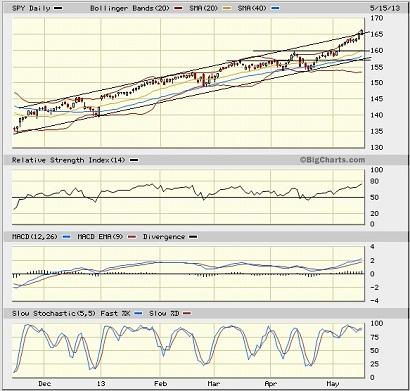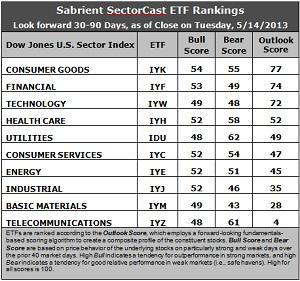 It seems that every Tuesday in 2013 since January 8 has been positive on the Dow. And this past Tuesday was no exception. Now that sounds like a trend to put money on — buy the SPDR Dow Jones Industrial Average ETF (DIA) at the close each Monday and close out the position late on Tuesday.
It seems that every Tuesday in 2013 since January 8 has been positive on the Dow. And this past Tuesday was no exception. Now that sounds like a trend to put money on — buy the SPDR Dow Jones Industrial Average ETF (DIA) at the close each Monday and close out the position late on Tuesday.
The Dow and S&P 500 both hit new all-time highs once again on Wednesday, while the Nasdaq hit its highest level since November 2000. The “risk on” allocation of new investment capital into cyclicals continues, although Wednesday saw leadership from defensive sectors Consumer Staples, Utilities, and Telecom, along with Financials. Nevertheless, ConvergEx reports that the average correlation of the ten S&P business sectors to the overall index averaged 82% last month. While that is below the 86% average of the past few years, it is still quite a bit higher than what we expect of a “healthy” market.
Investors have been climbing a “wall of worry” by focusing on their Silver Linings Playbook. And there’s little doubt that the silver linings are growing more prominent. The US economy is improving while unemployment is falling. Bank balance sheets are solid while corporations enjoy historically high levels of cash, and they are deploying their cash for stock buybacks and acquisitions. Most retail investors are still on the sidelines with cash at the ready, and they are starting to show an appetite for equities. Housing is displaying sound footing as demand and prices both rise. Increasing asset values of homes and stock portfolios are creating a wealth effect that is spurring consumer spending.
Furthermore, corporate earnings have been growing, but there has not been much top-line growth as businesses have been reluctant to expand, choosing instead to rely upon cost-cutting and increased productivity. However, confidence in the global economy and increased consumer spending should eventually get them to start hiring again.
Another positive for the long-term health of the global economy is the boom in North American oil and gas production (primarily related to shale and oil sands, as well as to the impact of new technologies on extraction from mature fields). As the US gradually moves toward the Holy Grail of energy independence, it would remove a major obstacle to growth that the “peak oil” doomsayers have been predicting. North America’s emerging competitive advantage with respect to energy costs is already starting to result in the on-shoring of manufacturing, reversing a troubling trend and giving hope to US job-seekers.
Of course, the Fed’s combination of near-zero Fed funds rate and quantitative easing has kept the yield curve both low and flat, thus pushing return-hungry investors into riskier assets like equities. But a big driver of this year’s sustained market strength has been the stabilization of sovereign debt in Europe, with Spanish and Italian bond yields falling from around 7% last year all the way down to around 4% today. And now Japan is reporting that its economy grew faster than anticipated during Q1, as consumer spending and exports rose in response to the country’s aggressive monetary and fiscal stimulus. This is all comforting news for investors.
Moreover, the US Congressional Budget Office now predicts a 2013 budget deficit of only $642 billion (4% of GDP), which is more than $200 billion below its February estimate, and is far below the $1.4 trillion deficit (10% of GDP) of 2009 and last year’s deficit of $1.1 trillion. The CBO now forecasts the 2015 budget deficit to fall to $378 billion (2.1% of GDP).
By the way, Sabrient’s “Baker’s Dozen” top 13 stocks for 2013 closed Wednesday up +22% since its inception on January 11. (Over the same timeframe, the S&P 500 is up +13%.) The portfolio’s performance is led by EPL Oil & Gas (EPL), Alaska Air Group (ALK), Genworth Financial (GNW), and Air Lease (AL). However, all 13 positions are positive, and 11 of them are up by double digits.
One of the keys to portfolio performance is avoiding meltdowns, and Sabrient’s proprietary Earnings Quality Rank (EQR) has been an important screening factor in the quant model that underlies the Baker’s Dozen selection process. EQR is a pure accounting-based risk assessment signal that was developed in conjunction with Sabrient subsidiary Gradient Analytics, a renowned forensic accounting research firm. On a scale of 1-5, with 5 the best (lowest risk), this year’s Baker’s Dozen portfolio reflects an average EQR of 4.2.
Looking at the chart of the SPY, it closed Wednesday slightly above 166. After closing Tuesday right at the upper line of the bullish rising channel that has been in place since November, Wednesday saw some minor weakness before bulls took the reins and pushed through the upper line. Still, oscillators like RSI, MACD, and Slow Stochastic are more overbought than they were last week, price is far extended beyond its moving averages and due for a reversion to the mean, and Bollinger Bands have grown inordinately wide. I expect price to pull back into the channel for some further technical consolidation before we see a concerted breakout.

The CBOE Market Volatility Index (VIX), a.k.a. “fear gauge,” closed Wednesday at 12.81, which is quite low and confirms bullish conviction. It has been not been above 20 at any time during 2013.
Latest rankings: The table ranks each of the ten U.S. business sector iShares ETFs by Sabrient’s proprietary Outlook Score, which employs a forward-looking, fundamentals-based, quantitative algorithm to create a bottom-up composite profile of the constituent stocks within the ETF. The multi-factor model considers forward valuation, historical earnings trends, earnings growth prospects, the dynamics of Wall Street analysts’ consensus estimates, accounting practices and earnings quality, and various return ratios. In addition, the table also shows Sabrient’s proprietary Bull Score and Bear Score for each ETF.
High Bull score indicates that stocks within the ETF have tended recently toward relative outperformance during particularly strong market periods, while a high Bear score indicates that stocks within the ETF have tended to hold up relatively well during particularly weak market periods. Bull and Bear are backward-looking indicators of recent sentiment trend.
As a group, these three scores can be quite helpful for positioning a portfolio for a given set of anticipated market conditions.

Observations:
1. Consumer Goods (IYK) takes over the top spot from Financial (IYF) with an Outlook score of 77, but the top three remain essentially in a dead heat, with IYF scoring 74 and Technology (IYW) scoring 72. Stocks within IYK continue to enjoy growing support from insiders and Wall Street an analysts (i.e., net upgrades in forward earnings estimates) and strong return ratios, although valuations (P/Es) are getting high. IYF displays strong sentiment among insiders and Wall Street analysts, as well as a low forward P/E.
2. Telecom (IYZ) stays in the cellar with an Outlook score of 4. It is weak in forward P/E, long-term projected growth, and return ratios, although it enjoys good Wall Street support. It is joined in the bottom two again this week by Basic Materials (IYM), which is seeing a continued acceleration in Wall Street earnings downgrades.
3. This week’s fundamentals-based rankings appear to have slipped to a neutral or even slightly defensive bias, with defensive sectors Consumer Goods (IYK), Healthcare (IYH), and Utilities (IDU) in the top five.
4. Looking at the Bull scores, IYK has been the surprising leader on particularly strong market days, scoring 54, followed closely by IYF at 53, while IYZ and IYW have been the laggards on strong market days, scoring 48. The narrow top-bottom spread has further tightened to only 6 points, which continues to indicate high sector correlation on strongly bullish days.
5. Looking at the Bear scores, Utilities (IDU) is still serving as the favorite “safe haven” on weak market days, scoring 62, followed closely by IYZ at 61, while Materials (IYM) is the worst during extreme market weakness as reflected in its low Bear score of 43. The top-bottom spread is 19 points, which continues to indicate lower correlations on weak market days, i.e., it pays to be in the safe sectors when the market is bearish.
6. Overall, Consumer Goods (IYK) shows the best all-weather combination of Outlook/Bull/Bear scores. Adding up the three scores gives a total of 186. Telecom (IYM) is the worst at 113. Looking at just the Bull/Bear combination, Utilities (IDU) and Healthcare (IYH) both display an impressive total score of 110, followed closely by Telecom (IYZ) and Consumer Goods (IYK) at 109. Materials (IYM) displays by far the lowest score at 92. This indicates that Utilities and Healthcare stocks have performed the best in extreme market conditions (whether bullish or bearish) while Materials stocks are avoided altogether.
These Outlook scores represent the view that Consumer Goods and Financial sectors may be relatively undervalued, while Telecom and Basic Materials sectors may be relatively overvalued based on our 1-3 month forward look.
Some top-ranked stocks within IYK and IYF include V.F. Corp (VFC), Ingredion Inc. (INGR), Markel Corp (MKL), and The Howard Hughes Corp (HHC).
Disclosure: Author has no positions in stocks or ETFs mentioned.
About SectorCast: Rankings are based on Sabrient’s SectorCast model, which builds a composite profile of each equity ETF based on bottom-up aggregate scoring of the constituent stocks. The Outlook Score employs a fundamentals-based multi-factor approach considering forward valuation, earnings growth prospects, Wall Street analysts’ consensus revisions, accounting practices, and various return ratios. It has tested to be highly predictive for identifying the best (most undervalued) and worst (most overvalued) sectors, with a 1-3 month forward look.
Bull Score and Bear Score are based on the price behavior of the underlying stocks on particularly strong and weak days during the prior 40 market days. They reflect investor sentiment toward the stocks (on a relative basis) as either aggressive plays or safe havens. So, a high Bull score indicates that stocks within the ETF have tended recently toward relative outperformance during particularly strong market periods, while a high Bear score indicates that stocks within the ETF have tended to hold up relatively well during particularly weak market periods.
Thus, ETFs with high Bull scores generally perform better when the market is hot, ETFs with high Bear scores generally perform better when the market is weak, and ETFs with high Outlook scores generally perform well over time in various market conditions.
Of course, each ETF has a unique set of constituent stocks, so the sectors represented will score differently depending upon which set of ETFs is used. For Sector Detector, I use ten iShares ETFs representing the major U.S. business sectors.
About Trading Strategies: There are various ways to trade these rankings. First, you might run a sector rotation strategy in which you buy long the top 2-4 ETFs from SectorCast-ETF, rebalancing either on a fixed schedule (e.g., monthly or quarterly) or when the rankings change significantly. Another alternative is to enhance a position in the SPDR Trust exchange-traded fund (SPY) depending upon your market bias. If you are bullish on the broad market, you can go long the SPY and enhance it with additional long positions in the top-ranked sector ETFs. Conversely, if you are bearish and short (or buy puts on) the SPY, you could also consider shorting the two lowest-ranked sector ETFs to enhance your short bias.
However, if you prefer not to bet on market direction, you could try a market-neutral, long/short trade—that is, go long (or buy call options on) the top-ranked ETFs and short (or buy put options on) the lowest-ranked ETFs. And here’s a more aggressive strategy to consider: You might trade some of the highest and lowest ranked stocks from within those top and bottom-ranked ETFs.

